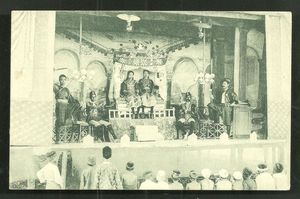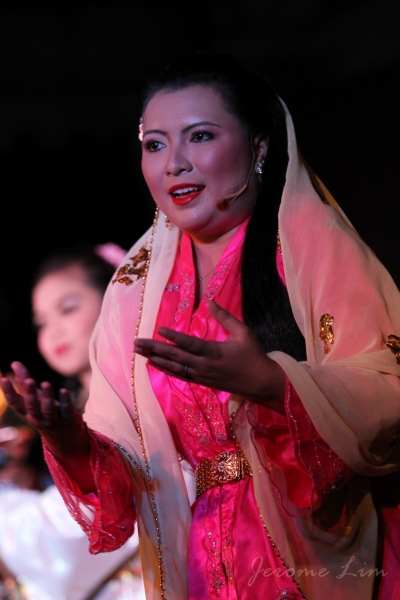Bangsawan In Singapore
3Bangsawan and the Bukit Brown connection. One of the earliest impresarios of traditional Malay Opera is buried in Bukit Brown and is highlighted in Group 2 Tour.
The Beginning of Bangsawan in Singapore
by Norman Cho
Before the advent of the television or the sound movies, theatrical performances were the few forms of entertainment available to the masses. One of which was the Bangsawan. The Bangsawan (Malay Opera) troupes consisted of professional Malay actors. The origins of the Bangsawan probably originated from the western plays. A small orchestra consisting of the violin, the accordion and local Malay percussion instruments such as the kompang, would normally accompany the stage-acts. Comedy and tragedy were the common genres. Stories which imbed morals were often told through these plays. While the plays were in Malay, the stories were adapted from legends and folklore from diverse origins such as Chinese, European, Hindi, Arabian and Malay. The classical Malay language was normally used. This would be a higher form of Malay that was used by the Malay Royal Courts, which was archaic.
The most renowned was the Star Opera Company (1909 – 1927) which was owned by the Peranakan brothers – K.H. Cheong (Cheong Koon Hong) and K.S. Cheong (Cheong Koon Seng) and was managed by their nephew Y.L. Tan (Tan Yew Lee). It was situated at Star Opera Hall – Theatre Royal, North Bridge Road. They accepted reservations through phone bookings as early as 1918. Tickets costs between $0.50 to $5. Star Opera was so popular that it received patronage from various Malay Royals like the Sulatan of Trengganu in 1910. Even the Europeans attended its 1914 production of Shakespeare’s “Hamlet” in Malay.
Their star artiste was Khairudin, also popularly known as Tairu (Tairo). His name was synonymous with the Bangsawan. He was so sought-after that his performances were frequently sold-out. As with many movie stars of today, fame invited gossip. Magic charms had been suggested for his unwavering popularity. The nyonyas mesmerized by Tairu’s dashing good looks, literally threw their jewellery on stage after each performance – a diamond ring or a hurriedly unfasten kerosang intan (diamond brooch) being the commonest items. Flustered Babas forbade their wives from attending his performance. His career peaked during 1918 but he stopped performing for the Star Opera around 1924 to start and star in a very successful company called “Dean’s Opera” also at Theatre Royal, North Bridge Road. He had probably taken over the venue from Star Opera Company. By then he billed himself as Kairo Dean. Born in Hong Kong in 1890, he came to Singapore in 1900 and studied in Belilios Public School. He was not very good at his studies and worked as a handbill boy for Wang Kassim at the age of 14, earning 15 cents per day. He was talent spotted by its director Gulam Mydin and the rest is now history…
Over at Frankel Estate’s Opera Estate, streets were not only named after European Operas like Tosca, Aida or Figaro. Jalan Bangsawan, Jalan Khairuddin and Jalan Bintang Tiga of the Malay Opera world could also be found.
More on Bangsawan by Norman Cho here
Recently Bangsawan was revived by the Singapore River. Read Jerome Lim’s blog for more.
This article is adapted by Norman from
“an article first published in The Peranakan, Issue 3, 2011, pp. 3. Reproduced courtesy of The Peranakan Association, Singapore”




Great to read! Khairuden was my great grandfather – recently when I went to Singapore I visited the street named after him…was nice to be in touch with a little family history. He sounded like someone our family can be really proud of.
Hi Junita.
Just to alert you there is a reply to your posting with an offer to pass on some recordings of your great grandfather
Miss Junita
I have some archive of your great grandfather recording on 78 rpm
if you like please contact me :azman4884@yahoo.com